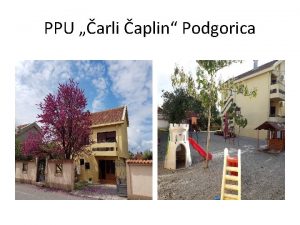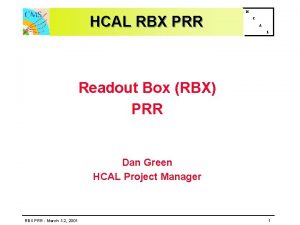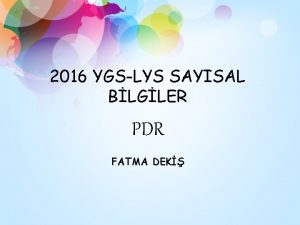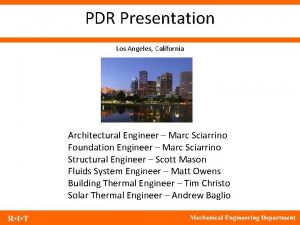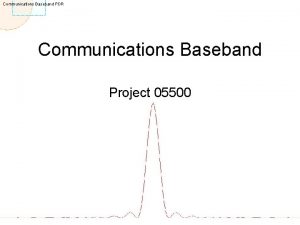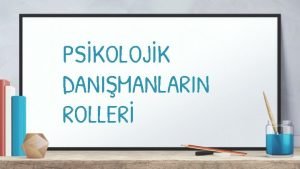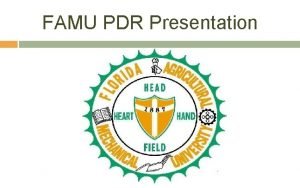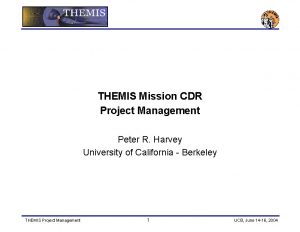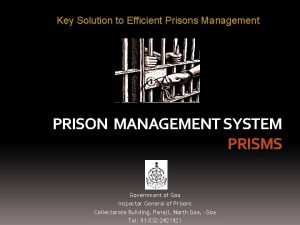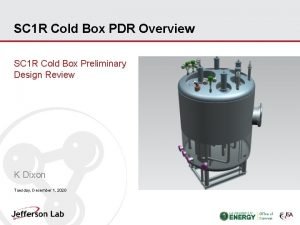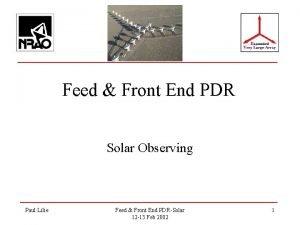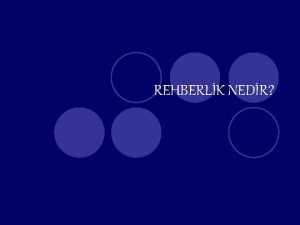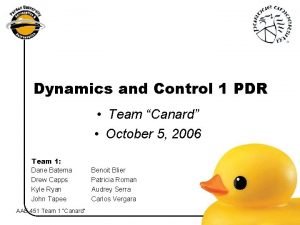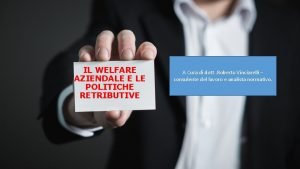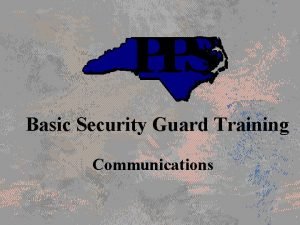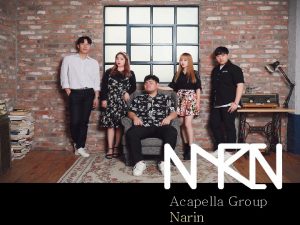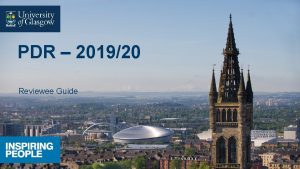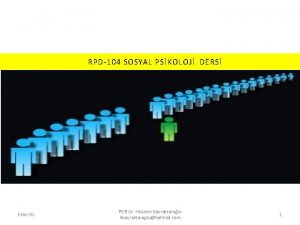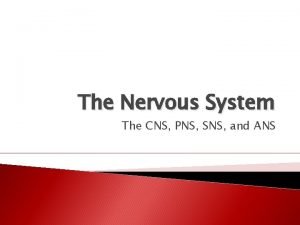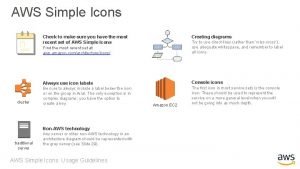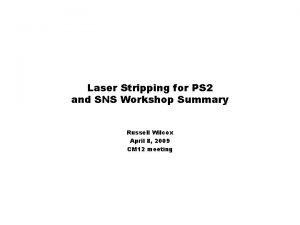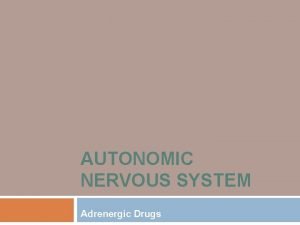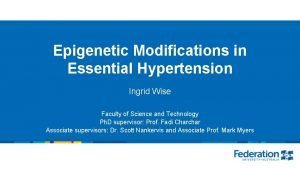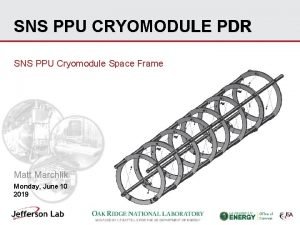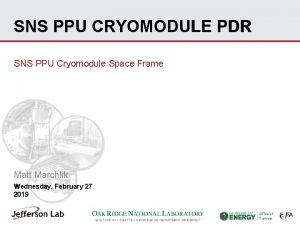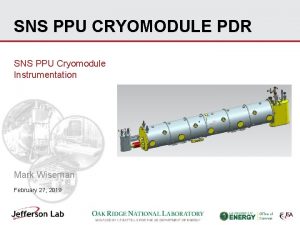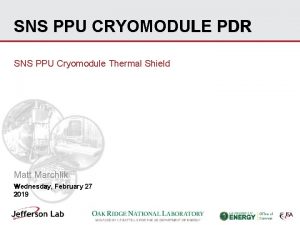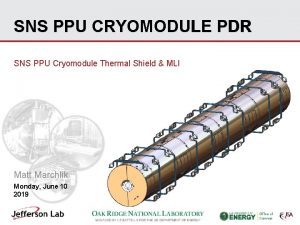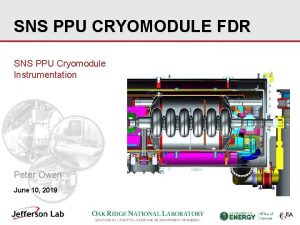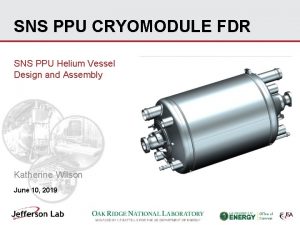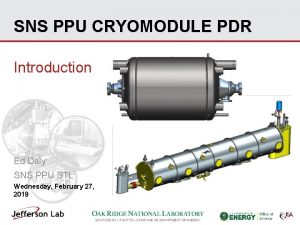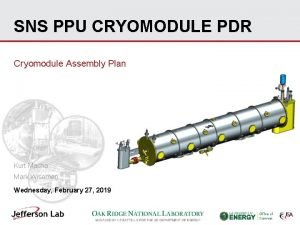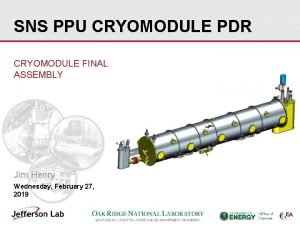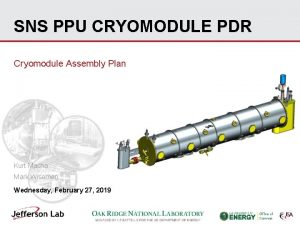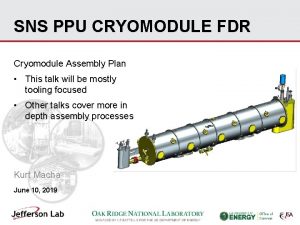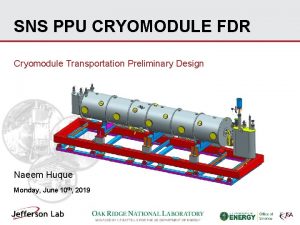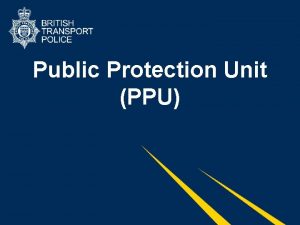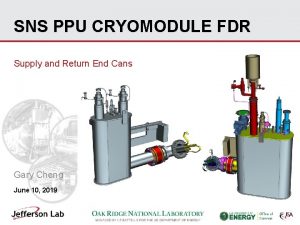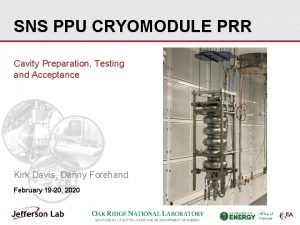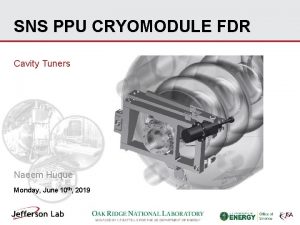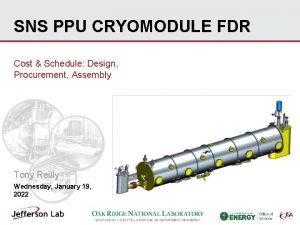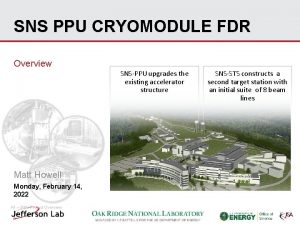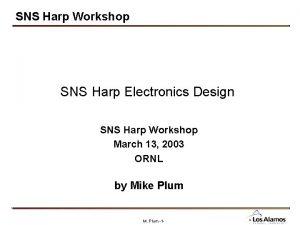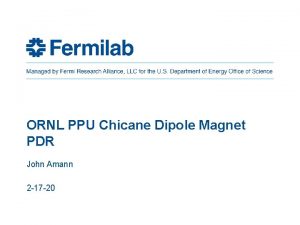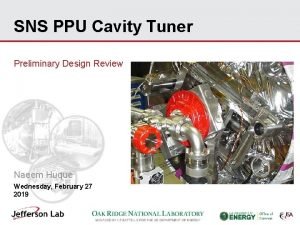SNS PPU CRYOMODULE PDR SNS PPU Cryomodule End


























- Slides: 26

SNS PPU CRYOMODULE PDR SNS PPU Cryomodule End Cans Gary Cheng Wednesday, February 27, 2019

OUTLINE • Introduction to SNS PPU End Cans • Justification of Design Changes • Supply End Can (SEC) Design Changes • Return End Can (REC) Design Changes • Pressure System Design • Shipping Load Considerations • Radiation Hardness • Procurement Relevant Topics • Plan Before FDR 2

Introduction to SNS PPU End Cans The CEBAF style cryomodule design adopts supply and return end cans, which are used to host supply and return cryogenic pipes as well as control valves. End cans permit to install, remove and cool down a cryomodoule independently from others. On the original SNS MB & HB cryomodules designed by JLab, SEC has 2 K primary supply, 50 K shield supply, two JT valves, two cryogenic pipe trapped volume pressure reliefs and instrumentation ports. The REC has 2 K return, 50 K return, cool down line return, cool down valve, 2 K pressure relief stack, pressure transducers and instrumentation ports. 3

Introduction to SNS PPU End Cans (Cont’d) The SNS HB Spare CM design moved the two JT valves from SEC onto the vacuum vessel, which merged the supply & return bridging rings that the original SNS CMs have. SNS PPU end cans are based on the SNS HB Spare CM design. After JLab design team reviewed the end can design, a series of design changes are initiated, with agreement from SNS. 4

Justification of Design Changes Three main reasons led the design team to make changes in the end cans: 1. In the REC, the clearance between thermal shield and 2 K surfaces is found to be narrow. 2. Both ORNL and JLab agree that adding bellows to the bridging pipes in between the end cans and vacuum vessel would permit adjustments when aligning the end cans to comply with the requirements in the Interface Control Drawing (ICD). § ORNL’s method of leaving a few welds to be done by ORNL cannot be implemented at JLab, which is not an ASME shop. § ORNL experience tells that it would require Survey & Alignment laser tracker measurements to guide the welder. 3. Shipping loads consideration. § Shipping loads were considered in the original MB & HB CM design. However, the end cans are redesigned by ORNL. § SNS PPU is based on the HB spare CM, which did not need to be shipped over a long distance. SNS PPU CMs need to travel > 500 miles. 5

Supply End Can Design Changes • A bellows is added to the bridging 6” OD tube. -Addition of a bellows is in the first place demanded by REC alignment, which is more difficult to do in practice. -The bellows may allow +/- 0. 25” transverse displacement and +/- 0. 5” tension/compression along the bellows axis -This bellows will need an ASME stamp. -A set of rotatable and fixed flanges is added too. Spacers between thermal shield and vacuum jacket need to have 0. 25” margin. May add springs to make contact for shipping loads. 6

Supply End Can Design Changes (Cont’d) • The support mount/block inserts into a socket engraved on the vacuum vessel’s SEC mounting pad. The socket allows 1/8” clearance all around the support block and +/- 0. 25” longitudinal adjustment. The bolt holes on the support plate have at least 1/8” clearance too. Welds will be done after the end can alignment to lock positions. -There is a concern about welding to affect the end can position. Consider to control welding sequence, use welding fixture or set screws. 7

Supply End Can Design Changes (Cont’d) • Pipes connecting to the female bayonets are of 3/4” NPS, no more necking down to 1/2“ NPS, no 3/4” to 1/2” reducer. • Added “pig tail” loops to the pressure tap lines to mitigate the risk of having thermoacoustic oscillation (TAO). • Weld unions added to the pressure tap lines to facilitate welding. • Lifting lugs added. A tapped hole on the support link is added so a 3 -point lift can be carried out. • Cernox diodes holder added. 8

Supply End Can Design Changes (Cont’d) • Tubular thermal shield inside the bridging tube is coped to allow more clearance to the run pipe. • The two thermal straps connecting the tubular and box thermal shields are reshaped. They have dual functions, i. e. thermal and structural links. • The threaded tube G-10 standoffs in between the tubular thermal shield and vacuum jacket in the bridging tube are replaced with G-10 spiders for more robust structural support during shipping. • Plan to label run pipes to avoid assembly error. 9

Return End Can Design Changes • A bellows is added to the bridging 8” OD tube. -Bellows specs same as those for the SEC bellows. • The support mount/block also inserts into a socket on the vacuum vessel REC mounting pad. -1/8” all around clearance -+/- 0. 25” longitudinal allowance -Bolt holes on the support plate are slotted to have at least 1/8” clearance -Weld to lock position after alignment 10

Return End Can Design Changes (Cont’d) A couple efforts are made to increase the clearances between thermal shield and colder surfaces: By making the REC shell and thermal shield concentric to each other (ONLY), some improvements in the clearances are achieved. The. 292 dimension represents the extra straight in the shield when it’s concentric. 11

Return End Can Design Changes (Cont’d) This depicts moving the heat exchanger a ½” and making the shell & shield concentric. Doing both seems to get tight spots close to a ¼ inch & vastly improves the long edge of the HX to the shield. 12

Return End Can Design Changes (Cont’d) • Reroute plumbing due to the move of HX and for simplicity. • The top pieces of thermal shield are combined into one. • The female bayonets are switched to JLab traditional design. • Pipes connecting to the female bayonets are of 3/4” NPS, no more necking down to 1/2“ NPS, no 3/4” to 1/2” reducer. • Added “pig tail” loops to the pressure tap lines to mitigate the risk of having TAO. • Added a weld union to a pressure tap line to facilitate welding. • Five Cernox diodes holders are added. 13

Return End Can Design Changes (Cont’d) • Added a structural support to the HX to resist beam axis shipping load. • The vertical long bent rod for HX support is replaced with two straight rods and an offset connector. The other rod is relocated for more clearance. • Lifting lugs added. A tapped hole on the support link is added so a 3 -point lift can be carried out. 14

Return End Can Design Changes (Cont’d) • Pressure transducer manifold adopts the typical CEBAF design to have a 30/30 gauge and VCR connections that will need adapters to the Honeywell pressure transducers that SNS PPU will use. • Switch the Circle Seal K 5120 B 10 MP-17 non-ASME PRV with a type RXSO 1 ¼ inlet, 1 ¼ outlet safety relief valve for the 17 PSID low pressure relief. It can be ASME certified. It has a Teflon seat. This PRV’s location is relocated 0. 5” in X direction (in/out of paper). 15

Return End Can Design Changes (Cont’d) • Plan to label the pipes going into the vacuum vessels to avoid assembly error. • To add 4 sets of G-10 standoffs to each of the two side thermal shields near the leading & trailing edges to resist shipping load. • Removed the aluminum weld protection shield. Resized tubular thermal shield to be larger to increase cryogenic pipe spacing. • Use spider supports between the bridging tube and its tubular thermal shield. Two of such supports need 0. 25” headroom. Consider adding springs for cushion shipping loads. 16

Pressure System Design • End can vacuum shells to have ASME BPVC stamps • Two major pressure piping in SEC. Five major pressure piping in REC. • Design pressures 33 psia, 165 psia, 200 psia, basing on the PRV settings. Design temperature 2 -300 K. Piping design per 2016 ASME B 31. 3. • 4 relief valves installed, two per end can. 17

Pressure System Design (Cont’d) • Pressure piping wall thicknesses checked against 2016 ASME B 31. 3 rules, no issues found. • Flexibility analysis, considering pressure and thermal contraction loads, will be carried out once plumbing work is finalized. This analysis will include the piping connections inside the cryomodule body that is being worked on. 18

Pressure System Design (Cont’d) • End can shell ASME analyses were performed by ORNL. Current plan is to inherit most, if not all, of ORNL’s code analyses. • ORNL noted JLab that the REC bridging pipe to vacuum shell welded connection may have high stress. JLab will work with ORNL to investigate this and come up with a resolution. • The addition of the bellows triggers revisiting of the shell ASME code analysis. • Pressure piping stress analysis will dictate whether Charpy impact tests are required. • All end can drawings will be reviewed for compliance with ASME codes, especially the weld callouts and applicable specifications (ASME, AWS). • Pressure system design documents will be stored under SNS PPU Pressure System folder. 19

Shipping Load Considerations • SNS PPU CM Shipping Load Design Requirements: -Vertical: 4 g -Longitudinal(beam axis): 5 g -Transverse: 1. 5 g -Accelerations to be applied independently. 0. 19 • SEC 2 K supply bayonet heat intercept to thermal shield brazed joint has been checked against shipping loads and found to be sufficient. • SEC support plate to support block 0. 19” fillet weld is also checked and found to be safe. 20

Shipping Load Considerations - SEC The SEC without most of its vacuum shell subjected to 4 g vertical acceleration is analyzed. Ø Model still uses the G-10 tubular standoffs inside the bridging tube. Ø Vertical deflection is acceptable. Ø Stainless steel pipes don’t experience high stress. Ø Thermal shield peak stress is localized and too high. Ø Hope that the spider support and adding springs will alleviate thermal shield stress. Stainless steel yield strength = 30 ksi 21 C 11000 H 00 copper yield strength = 10 ksi

Shipping Load Considerations - REC • On the REC, the 3 -1/8” 2 K return bayonet to box-shape thermal shield brazed joint is found insufficient to resist the shipping accelerations. • The 0. 19” fillet weld connecting the support plate and block is safe against all accelerations. • Plan is to add more standoffs to the box-shape thermal shield’s leading and training edges, if proceeding along the beam axis, to help in resisting the 5 g acceleration. • Once the internal piping work completes, detailed analyses will be run to check the structural integrity of REC during shipping. 22

Radiation Hardness Considerations • O-ring candidate materials Viton has max radiation tolerance of 5 x 107 rads and EPDM has 1 x 108 rads. • Chevron material PTFE can only take 1 x 105 rads. Years ago, JLab cryo group changed chevron material to Ultra High Molecular Weight Polyethylene (UHMW PE). ORNL prefers to use High Density Polyethylene (HDPE). • Plan is to go through all seals materials to make sure the right materials are called out. For example, the 3 -1/8” bayonet o-ring, item 19, is called out to be Viton. Item 14, the V-rings are currently called out as PTFE, which will be changed to HDPE instead. 23

Procurement Relevant Topics • HX is on the list of early procurement items. Its design has not been changed so the relevant drawings are ready to go. Statement of work needs to be reviewed to make sure that its content complies with the latest regulations on pressure systems. • Vendor is expected to stamp both the SEC and REC. • All welds on the pressure boundary will be required to observe ASME code rules. Requirements on submission of Co. C, material certificates, serialization, WPS, PQR, WPQ, inspections & reports, etc. will be laid out in the SOW. Cold shock, pressure test and leak check will be enforced. • Vendor needs to record SNs and locations of Cernox diodes. • Charpy impact test might be required. 24

Plan Before FDR • Both the SEC and REC designs are still ongoing. All mentioned design changes need to be implemented and evaluated. • End can due pressure system analyses need to be carried out and design changes may be needed depending on the results. • Shipping load analyses also need to be performed to check the robustness of critical welds, fasteners, etc. This likely will demand more design changes. • As it appears, a good percentage of end can drawings will need to be revised or re-created. 25

Gary Cheng Jefferson Lab, Newport News, VA THE END cheng@jlab. org Comments and suggestions are appreciated! 26
 Vrtic pinokio kod delte
Vrtic pinokio kod delte Rbx cal
Rbx cal Uci cinema pdr
Uci cinema pdr 2016 pdr sıralama
2016 pdr sıralama Pdr architects
Pdr architects Communications board
Communications board Pdr nin geleceği
Pdr nin geleceği Famu pdr
Famu pdr Pdr cdr project management
Pdr cdr project management Pdr prisoner
Pdr prisoner Pdr compressor
Pdr compressor Sfu pdr
Sfu pdr Pdr temel kavramlar
Pdr temel kavramlar Risk event life cycle
Risk event life cycle Aircraft static margin
Aircraft static margin Decontrib pdr dl 50/17
Decontrib pdr dl 50/17 Security guard radio codes
Security guard radio codes Narin acapella members
Narin acapella members Pdr preliminary design review
Pdr preliminary design review Pdr objectives examples
Pdr objectives examples Völkerpsikoloji
Völkerpsikoloji Cns and sns
Cns and sns Aws sns icon
Aws sns icon Sns workshop
Sns workshop Acute bronchospasm
Acute bronchospasm Limbic system and trauma
Limbic system and trauma Sns
Sns
